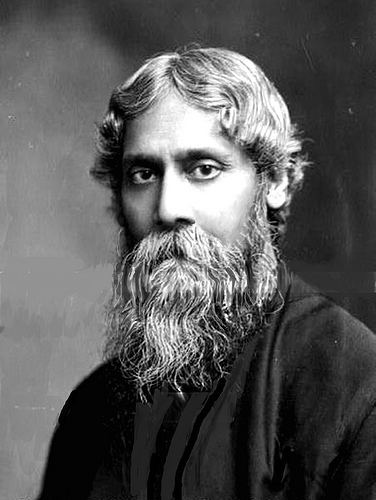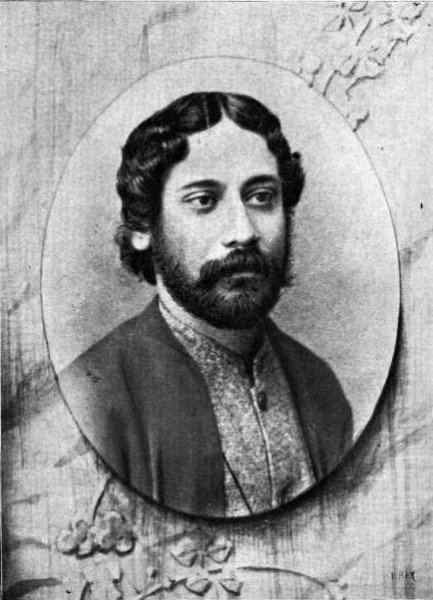Nationality British Indian | Occupation Religious reformer Role Philosopher Ethnicity Bengali Hindu Name Debendranath Tagore Spouse Sarada Devi | |
 | ||
Grandchildren Sarala Devi Chaudhurani, Madhurilata Tagore Similar People Rabindranath Tagore, Dwarkanath Tagore, Satyendranath Tagore, Jyotirindranath Tagore, Dwijendranath Tagore | ||
Biography of Debendranath Tagore, Hindu philosopher, religious reformer & founder of Brahmo religion
Debendranath Tagore (Bengali: দেবেন্দ্রনাথ ঠাকুর, Debendronath Ţhakur) (15 May 1817 – 19 January 1905) was a Hindu philosopher and religious reformer, active in the Brahmo Samaj ("Society of Brahman," also translated as "Society of God"), which aimed to reform the Hindu religion and way of life. He was one of the founders in 1848 of the Brahmo religion, which today is synonymous with Brahmoism.
Contents
- Biography of Debendranath Tagore Hindu philosopher religious reformer founder of Brahmo religion
- Debendranath Tagore and Keshub Chandra Sen socio cultural reformer
- Thakur Bari House of Tagores
- Children
- Religion
- Influence and Views on the Brahmo Samaj
- Tributes
- References

A Bengali, he was born in Shilaidaha. His father was the industrialist Dwarkanath Tagore.

Debendranath was a deeply religious man. His movement, the Brahmo Samaj, was formed in 1843 by merging his Tattwabodhini Sabha with the Brahmo Sabha, ten years after the death of Raja Ram Mohan Roy, founder of the Brahmo Sabha. The Brahmo Sabha had fallen away from its original aims and practices, as stated in its Trust deed of Brahmo Sabha. However, Tagore aimed to revive the importance of this deed.

Although Debendranath was deeply spiritual, he managed to continue to maintain his worldly affairs – he did not renounce his material possessions, as some Hindu traditions prescribed, but instead continued to enjoy them in a spirit of detachment. His considerable material property included estates spread over several districts of Bengal; most famously, the Santiniketan estate near Bolpur in the Birbhum district, a later acquisition, where his eldest son Dwijendranath Tagore set up his school.

Debendranath was a master of the Upanishads and played no small role in the education and cultivation of the faculties of his sons.
Debendranath Tagore and Keshub Chandra Sen (socio cultural reformer)
Thakur Bari (House of Tagores)
Debendranath Tagore was born to the Tagore family in Jorasanko, popularly known as Jorasanko Thakur Bari in North-western Kolkata, which was later converted into a campus of the Rabindra Bharati University. The Tagore family, with over three hundred years of history, has been one of the leading families of Calcutta, and is regarded as a key influence during the Bengal Renaissance. The family has produced several persons who have contributed substantially in the fields of business, social and religious reformation, literature, art and music.
Children
Dwijendranath (1840–1926) was an accomplished scholar, poet and music composer. He initiated shorthand and musical notations in Bengali. He wrote extensively and translated Kalidasa's Meghdoot into Bengali.
Satyendranath (1842–1923) was the first Indian to join the Indian Civil Service. At the same time he was a scholar.
Hemendranath (1844–1884) was the scientist and organiser of the family. He was a spiritual seer and Yogi and he was responsible for development of modern Brahmoism which is now the Adi Dharm religion. He was a "doer" of his Tagore generation and worthy successor to his grandfather Dwarkanath and father. He sided with his "conservative" siblings Dwijendranath and Birendranath in the family disputes against "modern" Satyendranath, Jyotindranath and Rabindranath.
Jyotirindranath (1849–1925) was a scholar, artist, music composer and theatre personality.
Rabindranath (1861–1941) was his youngest son. A Nobel laureate in Literature, his poems have been adopted as national anthems of India and Bangladesh. Rabindranath founded the Vishwabharathi University in the Shantiniketan Estate acquired by his father.
His other sons were Birendranath (1845–1915) and Somendranath.
His daughters were Soudamini, Sukumari, Saratkumari, Swarnakumari (1855–1932) and Barnakumari. Soudamini was one of the first students of Bethune School and a gifted writer. Swarnakumari was a gifted writer, editor, song-composer and social worker. All of them were famous for their beauty and education. His part in creating the legacy of Thakurbari – the House of Tagore – in the cultural heritage of Bengal, centred in Kolkata, was not negligible. It was largely through the influence of the Tagore family, following that of the writer Bankim Chandra Chatterjee, that Bengal took a leading role on the cultural front as well as on the nationalistic one, in the Renaissance in India during the nineteenth century.
Religion
As son of Dwarkanath Tagore, a close friend of Ram Mohan Roy, Debendranath came early into the influence of Brahmoism through the Brahmo Sabha, a reformist movement in Hinduism formulating as Adi Dharma (Original Dharma) what it considered as the original pristine principles of Hinduism corrupted over time.
But even earlier, deeply affected in childhood by the death of his grandmother to whom he was greatly attached, Debendranath was drawn to religion and began contemplating the meaning and nature of life. He commenced a deep study of religious literature, particularly the Upanishads. In 1839, with tutelage from Pandit Ram Chandra Vidyabageesh, a leader of the Brahmo Sabha, he formed his own active Tattwabodhini Sabha (Truthseekers' Association) to spread his new experiences and knowledge.
In 1843, Debendranath started the Tattwabodhini Patrika as mouthpiece of the Tattwabodhini Sabha. In the same year, he revived the Brahma Sabha, fallen in vigour and following since the death of Ram Mohan Roy in 1833. The Brahmo Sabha was formally absorbed into the Tattwabodhini Sabha and renamed as Calcutta Brahma Samaj. The day Pous 7 of the Bengali calendar is commemorated as the foundation day of the Samaj. The Patrika became the organ of the Samaj and continued publication till 1883.
In 1848, Debendranath codified the Adi Dharma Doctrine as Brahmo Dharma Beej (Seed of the Brahmo Dharma). In 1850, he published a book titled Brahmo Dharma enshrining the fundamental principles. These principles emphasise monotheism, rationality and reject scriptural infallibility, the necessity of mediation between man and God, caste distinctions and idolatry.
With the influence of Brahmoism under Debendranath spreading far and wide throughout India, he gathered reputation as a person of particular spiritual accomplishment and came to be known as Maharshi. His spiritual stature was confirmed by Sri Ramakrishna, the great Hindu sage of the 19th century who paid Debendranath a visit.{cn|date=October 2015} Mentioned in the Gospel of Ramakrishna - Abridged version from Page 347 to 350} Debendranath's roles in the Bengal renaissance and the reform and rejuvenation of Hindu religion are considerable.
Influence and Views on the Brahmo Samaj
In 1843, Debendranath Tagore became the leading force of the Brahmo Sabha, which he renamed to Brahmo Samaj. Debendranath wished to changed the goal of Brahmoism to act as a vehicle for theological and social renewal. In opposition to the founder of the Brahmo Movement under Rammohun Roy who expressed Unitarinism and Universalism, Debenranath wished to assert the cultural and theological primacy of Vedantic Hinduism. This change is likely due to increasing pressures from Christian propaganda
Tributes
Sivanath Sastri has paid glowing tributes to Debendranath Tagore in History of the Brahmo Samaj:
Maharshi Debendranath Tagore was one of the greatest religious geniuses this country ever produced. He was truly a successor of the great rishis of old. His nature was essentially spiritual. ... He was a devout follower of the Upanishadic rishis, but was no pantheist on that account. Debendranath in spite of his real sainthood never put on the grab or habits of sadhu or saint. His piety was natural, habitual and modest. He hated or shunned all display of saintliness...
He was a true and living embodiment of that teaching of the Gita where it is said: “A truly wise man is never buffeted by his trials and tribulations, does not covet pleasure, and is free from attachment, fear and anger; the same is a muni.” Maharshi Debendranath was a true muni in that respect. He calmly bore all; even the greatest griefs of life. After having done his duty, he quietly rested, regardless of consequences.
Though personally not much in favour of the idea of female emancipation, he was one of the first men in Bengal to open the door of higher education to women. Valuing conscience in himself, he valued it in all about him. Religious life was growth to him; not an intellectual assent but a spiritual influence that pervaded and permeated life; consequently, he had not much sympathy with merely reformatory proceedings.
From the west he took only two ideas: first, the idea of fidelity to God; secondly the idea of public worship; in all other things he was oriental. His idea was to plant the Samaj in India, as the Hindu mode of realising universal theism, leaving the other races to realise that universal faith according to their traditional methods.
